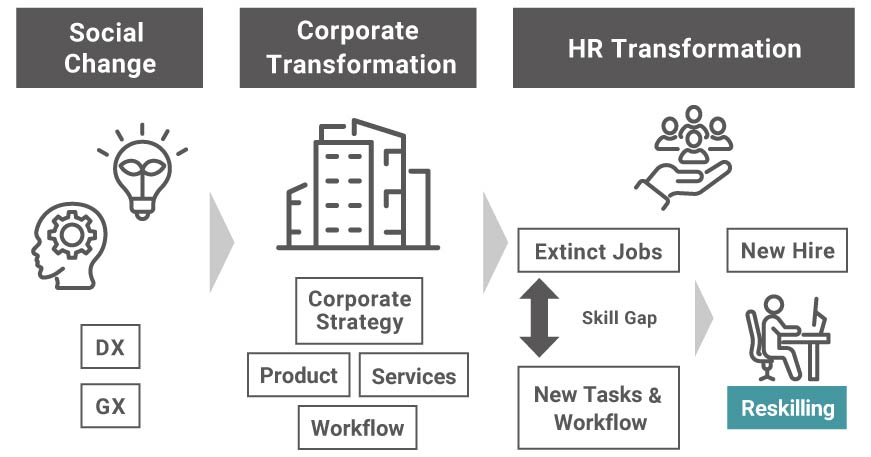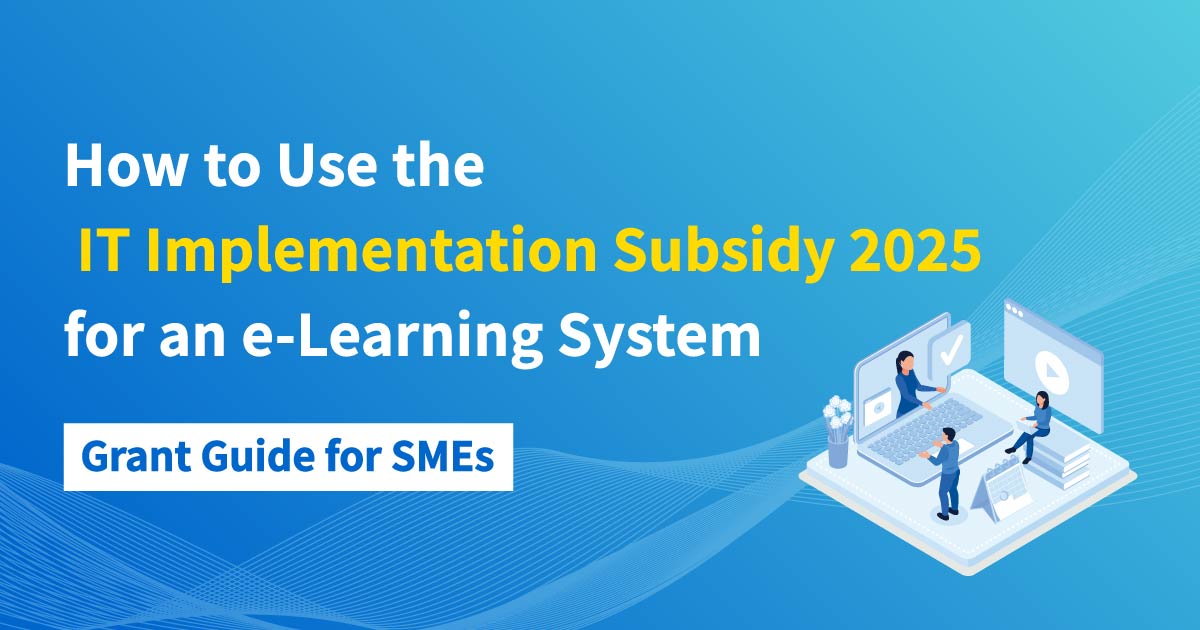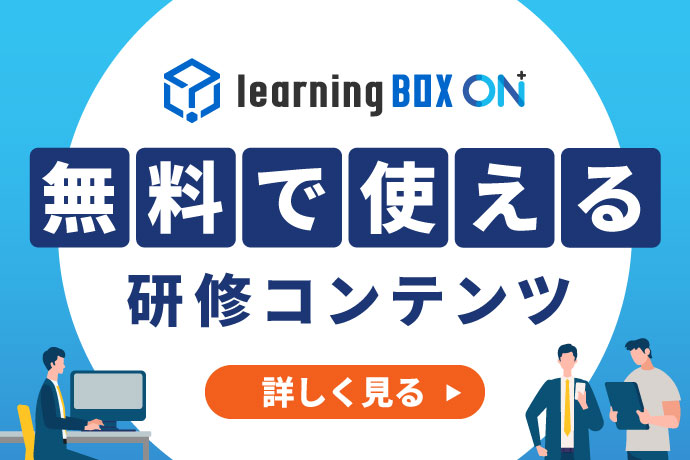Benefits of Reskilling your Employees

An increasing number of companies are focusing on hiring professionals and training existing employees for the purpose of fundamental innovation for existing businesses, which includes improving productivity and developing new businesses along with technological advancement.
When it comes to recruitment costs and opportunities, however, hiring professionals comes with challenges, and many organizations are now shifting to empower reskilling existing employees aiming to create new values and enhance new or existing businesses with digital transformation.
Regardless of the trend above, it is true that L&D or HR pros are struggling to successfully reskill employees in many cases. This is because they are on the way to find specific strategies, and are repeating trial and error. In this article, we explore the successful reskilling for existing employees, introducing some tips to follow.
What is Reskilling?

Reskilling refers to the process of learning new skills for a different job role within the organization. It typically occurs when there is a significant change in an employee’s previous tasks or responsibilities.
Large investments have been made for the corporate strategies in many countries. The Japanese government mentioned the desperate need for human resource development and reskilling in the statement in 2021, and there has been a growing interest in this field.
Difference between Reskilling and Relearning
What is the difference between reskilling and relearning? In terms of the purpose, there are quite different factors. The focus of relearning is to enhance individual skills for better performance within the current job role. On the other hand, reskilling is part of a company's business strategy to create new value.
| Reskilling | Relearning | |
|---|---|---|
| Definition | Acquiring the skills and knowledge required for new tasks | Repeating learning and performing through life |
| Objectives | Empowering employees to be professionals for a different job role | Improving skills to better perform in current roles |
| Subject | Organization | Individuals |
Why is Reskilling Important?

One of the reasons why reskilling is attracting attention is the proliferation and promotion of DX (Digital Transformation) and GX (Green Transformation). Due to technological advancement, companies are now required to make drastic changes in their management structure for strategies, services and workflows. As a result, new job roles and workflows are being created, and it is becoming an urgent need to determine employees who can handle them.
Back to ContentsBackground

When it comes to the background of reskilling, let us focus on three factors: market trends, management strategies and human resource development.
Market Trend
One major factor is the rapid changes in the external environment (market). Three main factors are listed below:
- Development of digital technology
- SDGs, ESG, LGBTQ, and other elements emphasizing corporate social responsibility and social impact
- Social change due to COVID-19 pandemic, etc.
Management Strategies
Along with the market change, corporate management strategies are required to go beyond the existing strategy process. Although improving operational efficiency with digital technology is necessary for the existing business, developing and expanding the digital transformation plays more important roles for the new business strategies.
HR Strategies
According to the market trends and business strategies mentioned above, hiring professionals seems to be a shortcut to create new value, however, the following two factors have been a hindrance.
- Overwhelming seller's market and severe shortage of professionals
- Unless a company has a large budget for recruitment, it is difficult to hire professionals and cannot be the main focus of human resource strategies.
For these reasons, reskilling existing employees becomes a key to success rather than hiring new personnel.
Back to ContentsBenefits of Reskilling

The following explain the benefits of reskilling.
Solving Shortage of Human Resources
As mentioned above, there are challenges to hire professionals for some reasons, and reskilling existing employees through training will result in solving the shortage of human resources. Furthermore, it will contribute to cost-cutting for the recruitment while eliminating talent shortages. Apart from recruiting, however, it should be noted that reskilling will take a certain period of time along with training cost.
Streamlining Business Process
In terms of digital skills, they will accelerate internal digital transformation within an organization, contributing to time and cost savings through automation and streaming of existing operations. In addition, centralized data management makes it easier to analyze accurate data. These internal innovations will result in reducing labor costs by decreasing overtime hours and improving work-life balance, enhancing new values for more advanced job roles.
Creating New Ideas
New skills go beyond the existing framework. They will lead to the growth of new business in addition to the existing one. Reskilling will unlock the potential to contribute to overall company growth.
New Business Initiatives
When external higher-level professionals are hired, there are some cases that the corporate philosophy and objectives do not match their thoughts. Internal personnel, on the other hand, will reduce such risk, expecting smoother communication with existing employees within an organization. Understanding corporate culture and operations plays a crucial role to build your new business initiatives, and reskilling cannot be underestimated for the success.
Back to ContentsKeys to Success

The following five steps will be a big help to implement reskilling in your organization.
STEP 1: Set the Project Scope
First of all, management and business strategies should be taken into consideration. According to the strategies, select the target job categories for reskilling. The scope can be categorized into quadrants based on its importance and number needed, and the one in the high importance quadrant and high number in the area will be the most important project scope. Even with limited resources, prioritized occupations will have the greatest impact on creating new value within the organization.
STEP 2: Clarify Job/Capability Requirements
Based on the project scope, clarify the targeted job description and capability requirements. For instance, the requirement could be management skills for the small-to-medium sized project. After that, subdivide each capability into elements of learning levels. This step will lead to an effective training program, enhancing the efficiency of reskilling.
STEP 3: Build a Training Program
Building a training program plays a crucial role in achieving goals. Training program and learning process should be well-designed, following the key steps for the objectives. The fundamental goals are determined at the STEP 2, and more detailed goals should be discussed: goals for each training program, creating program schemes, initiatives to improve learning retention, effective learning process based on the before-and-after program and more.
STEP 4: Conducting a Training Program
When conducting a training program, instructors and well-prepared lectures are the key to success. Instructors should be familiar with the elements of learning, and able to deliver lectures that meet the learners’ levels of understanding while motivating them. Moreover, flexibility to respond to unexpected changes is required. With those preparation will lead to the successful completion of STEP 3.
STEP 5: Effectiveness Measurements for the Advanced Stage
After completing a series of off-the-job training, measure the effectiveness, and follow up on-the-job training. This method helps to find how much each training has made it successful, or where the elements are lacking to achieve goals. For the latter elements, measures may include additional off-the-job training, improvement of the training environment and promoting on-the-job training with other departments. Monitoring on-the-job is also an effective method to achieve goals. These improvements will result in essential factors to enhance the future reskilling program.
Back to ContentsSummary
In this article, we explore the specifics of reskilling. According to the effectiveness mentioned above, the power of reskilling should not be underestimated for your business since it will contribute to the innovation for the existing business strategies, solution for shortage of human resources, developing new business strategies driven in continuous digital transformation and more.
Talking about the implementation of reskilling programs, well-structured plans and effective learning will lead to success. Some tools can be a good ally for reskilling programs, andlearningBOX is one of the recommended tools. learningBOX is an award-winning SaaS, and you can create content, manage scores and users online. This e-learning system offers all-in-one solutions with a variety of functionality and intuitive design.
In addition, learningBOX offers a Free Plan, which includes 10 accounts without expiry date. If you are a HR or L&D professional, it will be worth trying the system as a part of training programs.
Now is the time to sharpen employees’ skills to empower your business.
▼You may also like:
Back to Contents



-
Discover rich featuresService Guide
-
Feel free to contact usGet in Touch
-
Try our Free PlanTry Free Plan









